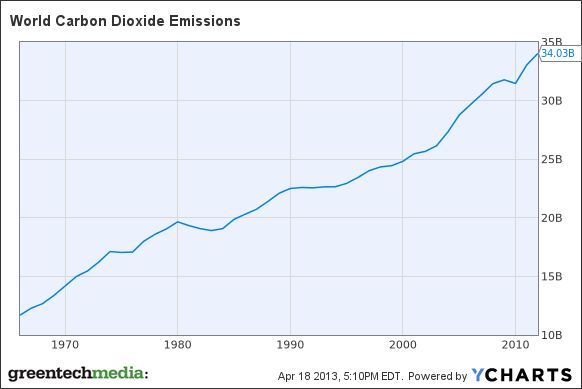Dirty energy is winning.
That's the conclusion of a new report from the International Energy Agency looking at the carbon intensity of the global energy system. Despite big drops in the cost of renewable energy systems and strong growth in deployment around the world, the fossil fuel industry remains unchallenged in its dominance, pushing global carbon emissions to increasingly dangerous levels without any signs of stopping.
This latest IEA analysis looks at the progress of renewable electricity, renewable fuels, hybrid vehicles, the smart grid, energy efficiency and carbon capture technologies. While there are clear signs that that these sectors are advancing, they are not advancing strongly enough to prevent global temperatures from rising by more than 2 degrees Celsius.
The 2-degree target is an internationally recognized threshold that guides climate talks; however, some climate scientists say that even that temperature rise is "a prescription for long-term disaster."
As IEA Executive Director Maria van der Hoeven points out in the introduction to the report, we are way behind in pretty much every area needed to address the global warming challenge.
"Progress is not fast enough; glaring market failures are preventing adoption of clean energy solutions; considerable energy efficiency potential remains untapped; policies must better address the energy system as a whole; and energy-related research, development and demonstration all need to accelerate," writes van der Hoeven.
Those “glaring market failures” include the lack of a price on carbon and the $1.9 trillion in subsidies to fossil fuels worldwide. While renewables have also recently enjoyed substantial government support in many countries, the failure to price global warming pollution sets them at a disadvantage as they compete with incumbent fossil fuel technologies, according to IEA.
The big story is the dominance of coal, which has prevented carbon dioxide emissions from falling in a significant way. Since 1990, CO2 emissions from the power sector have fallen by less than 1 percent, as coal consumption has grown faster than renewables. But change has been "alarmingly slow" in all sectors, writes IEA.
For a sobering look at how a look at how weak carbon intensity reductions have been, see the chart below:
“The global aggregate impact of all changes in supply technologies since 1970 has been minimal. Responses to the oil shocks of the 1970s made the energy supply 6% cleaner from 1971 to 1990. Since 1990, however, the [carbon intensity index] has remained essentially static, changing by less than 1%,” according to the report.
Renewable electricity technologies like solar PV, wind, biomass and hydro are all on track to hit penetrations that theoretically meet a 2-degree Celsius temperature rise, according to IEA. However, the continued growth in fossil fuel consumption is negating these gains. And with energy demand set to increase by 25 percent in the next ten years, energy efficiency is one of the most important tools for stabilizing emissions. IEA says that the carbon-intensity index referenced above needs to drop by 64 percent in the next four decades -- a difficult task without strong efficiency efforts.
This is the latest report from a major international institution sounding the alarm on slow progress in the energy sector. Last year, the World Bank warned that the world is on track for a 4 degree Celsius temperature rise by the end of the century (or even as early as 2060) without drastic reductions in carbon dioxide emissions. That kind of temperature increase would create a "warmer world marked by extreme heat-waves, declining global food stocks, loss of ecosystems and biodiversity, and life-threatening sea level rise."
As IEA's latest assessment clearly points out, there are few indications the world is anywhere close to realizing the deep emissions reductions needed to avert disaster. Renewables are making strong deployment gains -- but they aren't yet putting us on a different path.
